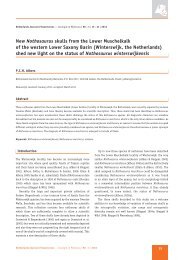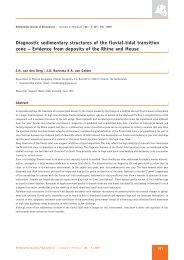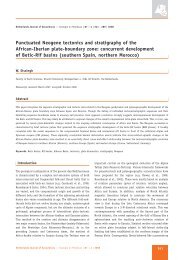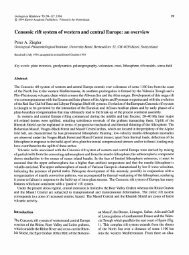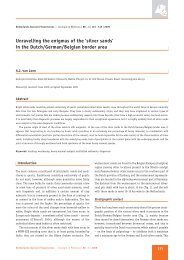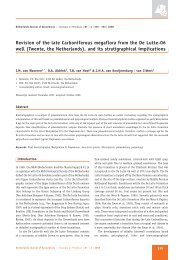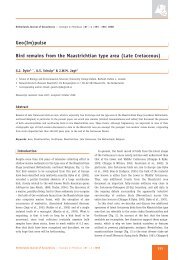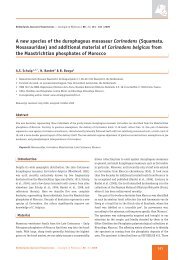Modelling of speleothems failure in the Hotton cave - Netherlands ...
Modelling of speleothems failure in the Hotton cave - Netherlands ...
Modelling of speleothems failure in the Hotton cave - Netherlands ...
You also want an ePaper? Increase the reach of your titles
YUMPU automatically turns print PDFs into web optimized ePapers that Google loves.
While <strong>in</strong> <strong>the</strong> previous case <strong>the</strong> centre <strong>of</strong> gravity <strong>of</strong><br />
<strong>the</strong> broken part from <strong>the</strong> speleo<strong>the</strong>m was considered<br />
at mid-height, ano<strong>the</strong>r case was envisaged with <strong>the</strong><br />
centre <strong>of</strong> gravity at αH from bottom. α is a non-dimensional<br />
parameter, rang<strong>in</strong>g from zero (<strong>failure</strong> section<br />
level) to one (top <strong>of</strong> <strong>the</strong> speleo<strong>the</strong>m). This position<br />
affects <strong>the</strong> value <strong>of</strong> <strong>the</strong> bend<strong>in</strong>g moment <strong>in</strong> <strong>the</strong><br />
<strong>failure</strong> section when <strong>the</strong> speleo<strong>the</strong>m is submitted to a<br />
ground movement.<br />
Failure<br />
section<br />
Ground<br />
motion<br />
H<br />
F = ma<br />
Fig. 6. Elevation view <strong>of</strong> a speleo<strong>the</strong>m and model.<br />
D<br />
Du<br />
Measured diameter Resistance + geometry<br />
Fig. 7. Failure section and cross section models.<br />
αH<br />
Dmean<br />
Local geometrical imperfections can lead to some<br />
stress concentrations. The value <strong>of</strong> <strong>the</strong> stress concentration<br />
factor ψ, ratio between <strong>the</strong> maximum stress<br />
σ max and <strong>the</strong> mean stress σ m, depends on <strong>the</strong> type <strong>of</strong><br />
notch. We will not consider <strong>the</strong> case <strong>of</strong> an already <strong>in</strong>itiated<br />
crack, for which ψ can be as high as 10 or 20,<br />
but simply <strong>the</strong> notch effect correspond<strong>in</strong>g to an irregular<br />
surface aspect which is commonly observed. It is<br />
similar to a semicircular notch (<strong>of</strong> radius ρ) hav<strong>in</strong>g<br />
<strong>the</strong> shape shown <strong>in</strong> Figure 8, for which tension tests<br />
on mortar specimens have <strong>in</strong>dicated a value around 2<br />
[Massonnet 1962].<br />
Consider<strong>in</strong>g <strong>the</strong> stress concentration factor, <strong>the</strong><br />
new position <strong>of</strong> <strong>the</strong> <strong>in</strong>ertia forces and <strong>the</strong> two different<br />
diameters D u and D mean <strong>of</strong> <strong>the</strong> cross section, it is<br />
possible to rewrite <strong>the</strong> formulas (2) and (3):<br />
Mru<br />
σ u = ψ<br />
I<br />
4<br />
= ψFαH<br />
3<br />
πru<br />
= ψma<br />
2 2<br />
H rmean<br />
*<br />
= 4αρ ψa<br />
3 g<br />
r<br />
u<br />
+<br />
*<br />
g<br />
4αH<br />
πr<br />
3<br />
u<br />
(4)<br />
(5)<br />
The ratio <strong>of</strong> <strong>the</strong> ground accelerations that leads to<br />
<strong>the</strong> <strong>failure</strong> <strong>of</strong> a speleo<strong>the</strong>m obta<strong>in</strong>ed with <strong>the</strong> two different<br />
models is :<br />
(6)<br />
The diameter variation <strong>of</strong> <strong>the</strong> sections along <strong>the</strong><br />
speleo<strong>the</strong>m can reasonably be estimated from 20% to<br />
30%. The diameter which is taken <strong>in</strong>to account to<br />
evaluate <strong>the</strong> resistance can vary about 10% around<br />
<strong>the</strong> measured value. And <strong>the</strong> level <strong>of</strong> <strong>the</strong> resultant <strong>in</strong>ertia<br />
force can be estimated to be between 0.3H and<br />
0.7H.<br />
From <strong>the</strong> formula (6), we obta<strong>in</strong> a ratio<br />
Tak<strong>in</strong>g <strong>in</strong>to account <strong>the</strong> geometry uncerta<strong>in</strong>ties<br />
and a possible stress concentration, <strong>the</strong> accelerations<br />
needed to break <strong>the</strong> <strong>speleo<strong>the</strong>ms</strong> by flexion can thus<br />
decrease to values between 0.3 m/s 2 and 100 m/s 2 .<br />
Conclusions<br />
The ma<strong>in</strong> conclusion <strong>of</strong> our mechanical tests and<br />
modell<strong>in</strong>g results is that horizontal acceleration values<br />
needed to break <strong>the</strong> <strong>speleo<strong>the</strong>ms</strong> <strong>of</strong> <strong>Hotton</strong> <strong>cave</strong><br />
are very scattered from 0.03 g to 10 g. Even if low accelerations<br />
were detected, globally <strong>the</strong> values are<br />
much higher than <strong>the</strong> peak ground acceleration expected<br />
from earthquakes. If <strong>the</strong> <strong>failure</strong> happens due<br />
320 Ne<strong>the</strong>rlands Journal <strong>of</strong> Geosciences / Geologie en Mijnbouw / 80(3-4) 2001<br />
ρ<br />
P<br />
σmax<br />
n<br />
P<br />
ρ<br />
σm<br />
3<br />
Du<br />
2<br />
mean<br />
* 1<br />
1<br />
ag =<br />
σ<br />
8<br />
2<br />
αρD<br />
H ψ<br />
a<br />
*<br />
g<br />
a<br />
a<br />
g<br />
*<br />
g<br />
a<br />
g<br />
⎛ Du<br />
⎞<br />
⎜ ⎟<br />
0.<br />
5 ⎝ D 1<br />
=<br />
⎠<br />
α<br />
2<br />
⎛ D ⎞ ψ<br />
mean<br />
⎜ ⎟<br />
⎝ D ⎠<br />
0.<br />
5<br />
=<br />
0.<br />
7<br />
Fig. 8. Shape <strong>of</strong> notch considered <strong>in</strong> <strong>the</strong> fatigue<br />
model<br />
3<br />
3 ( 0.<br />
9)<br />
1 1<br />
= .<br />
2 ( 1.<br />
3)<br />
2 6.<br />
5<br />
u



